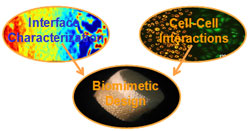> RESEARCH
Interface Tissue Engineering and the Formation of Complex Tissue Systems
 Our Research Program centers on understanding how the biological interface between different types of connective tissues are formed and maintained in the body, and more importantly, how to re-establish these distinct tissue-to-tissue boundaries post injury. Our approach is to regenerate the native tissue-to-tissue interface on biological and synthetic grafts, with the extended goal of engineering complex tissues or organ systems pre-designed to integrate with the host environment. The working hypothesis is that heterotypic cellular communications play a significant role in the regeneration and homeostasis of distinct skeletal tissue boundaries. Specifically, our approach to interface tissue engineering include three closely related areas:
Our Research Program centers on understanding how the biological interface between different types of connective tissues are formed and maintained in the body, and more importantly, how to re-establish these distinct tissue-to-tissue boundaries post injury. Our approach is to regenerate the native tissue-to-tissue interface on biological and synthetic grafts, with the extended goal of engineering complex tissues or organ systems pre-designed to integrate with the host environment. The working hypothesis is that heterotypic cellular communications play a significant role in the regeneration and homeostasis of distinct skeletal tissue boundaries. Specifically, our approach to interface tissue engineering include three closely related areas:
- Characterize the structure-function relationship at the soft tissue-to-bone interface
- Elucidate the mechanism for interface regeneration and homeostasis, focusing on the role of heterotypic cellular interactions
- Design biomimetic, stratified scaffold systems able to control cellular interactions and promote the formation of complex tissues
Understanding tissue-to-tissue integration is also essential for connecting together different tissue engineered orthopaedic grafts, as biological fixation will be critical in facilitating the translation of these tissue engineered technologies to the clinic. Currently, we are conducting research on several interface tissue engineering areas.
Novel Biomaterials Design and Cell-Biomaterial Interactions
- Composite Biomaterials for Orthopaedic Tissue Engineering
- Dental Biomatarials and Tissue Engineering
